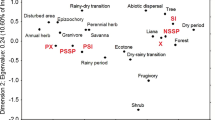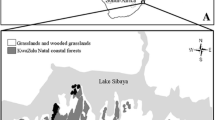Abstract
Four types of floral breeding systems—(i) chasmogamy, (ii) aerial pseudocleistogamy, (iii) subterranean pseudocleistogamy and (iv) obligate subterranean true cleistogamy—are observed in the populations ofVigna minima inhabiting the Western Ghats (India). Five categories of phenotypes are recognized based on the number and kinds of floral breeding systems found in a given individual. The frequencies of different categories of phenotypes not only show intra- and interpopulation variation, but also fluctuate from generation to generation suggesting differences in the genetic structure of populations. This polymorphism in the breeding system of a single species is unique and may be adaptive. Obligate subterranean true cleistogamy and amphicarpy appear to be adaptations to jungle fires and soil erosion.—The flowers are of the flag-blossom type and insect visitors act as tripping agents. The tripping mechanism together with the polymorphic floral breeding system result in a balanced mixture of selfing and outcrossing. Such a recombination system may enhance the fitness ofV. minima which is essentially a colonizing species.
Similar content being viewed by others
References
Arroyo, M. T. K., 1981: Breeding system and pollination biology inLeguminosae. — InPolhill, R. M., Raven, P. H., (Eds.): Advances in Legume Systematics, Part 2, International Legume Conference, 1978, pp. 723–769. — Kew, London.
Bates, R. P., Henson, P. R., 1955: Studies of inheritance inLespedeza cuneata Don. — Agron. J.47, 503–507.
Bernström, P., 1950: Cleisto-chasmogamic seed-setting in di- and tetraploidLamium amplexicaule. — Hereditas36, 492–506.
Brown, W. V., 1952: The relation of soil moisture to cleistogamy inStipa leucotricha. — Bot. Gaz.113, 438–444.
Clay, K., 1982: Environmental and genetic determinants of cleistogamy in a natural population of grassDanthonia spicata. — Evolution36, 734–741.
Connor, H. E., Matthews, B. A., 1977: Breeding system in New Zealand grasses. VII. Cleistogamy inMicrolaena. — New Zealand J. Bot.15, 531–534.
Cope, W. A., 1966: Growth rate and yield in sericeaLespedeza in relation to seed size and outcrossing. — Crop Sci.6, 566–568.
Donnely, E. D., 1979: Selection for cleistogamy in sericeaLespedeza. — Crop Sci.19, 528–530.
Ernst-Schwarzenbach, M., 1956: Kleistogamie and Antherenbau in der Hydrocharitaceen-GattungOttelia. — Phytomorphology6, 296–311.
Free, J. B., 1970: Insect Pollination of Crops. — New York: Academic Press.
Girardeau, J. H., Leuck, D. B., 1967: Effect of mechanical and bee tripping on yield of pea nut. — J. Econ. Entom.60, 1454–1455.
Goebel, K., 1904: Die Kleistogamen-Blüten und die Anpassungstheorien. — Biol. Zentralbl.24, 673–697, 737–763, 769–787.
—, 1905: Chasmogamie und Kleistogamie der Blüten beiViola. — Allg. Bot. Z. Syst.95, 234–239.
Gopinathan, M. C., Babu, C. R., 1986: A unique growth pattern in a tropical legumeVigna minima. — Bot. J. Linn. Soc.92, 263–268.
Grant, V., 1958: The regulation of recombination in plants. — Cold Spring Harbor Symp. Quant. Biol.23, 337–363.
Harlan, J. R., 1945: Cleistogamy and chasmogamy inBromus carinatus. — Amer. J. Bot.32, 66–72.
Haskell, G., 1954: Adaptation and the breeding system in groundsel. — Genetica26, 468–484.
Heslop-Harrison, J., 1959: Photoperiod and fertility inRottboellia exallata L. — Ann. Bot.23, 346–349.
Holden, J. J. W., Bond, D. A., 1960: Studies on the breeding system of the field beanVicia faba L. — Heridity15, 175–192.
Hutton, E. M., 1960: Flowering and pollination inIndigofera spicata, Phaseolus lathyroides, Desmodium uncinatum and some other tropical pasture legumes. — Emp. J. Exp. Agric.28, 235–243.
Jain, S. K., 1975: Population structurs and the effects of the breeding system. — InFrankel, O., Hawkes, J. G., (Eds.): Crop Genetic Resources for Today and Tomorrow, pp. 15–36. — Cambridge: Cambridge Univ. Press.
—, 1968: Simulations of models involving mixed selfing and random mating. I. Stochastic variation in outcrossing and selected parameters. — Heredity23, 411–432.
Khoshoo, T. N., Mehra, R. C., Bose, K., 1969: Hybridity, polyploidy and change in breeding system in aRuellia hybrid. — Theor. Appl. Genet.33, 133–140.
Lee, C. W., Erikson, H. J., Janick, J., 1976: Inheritance of cleistogamy inSalpiglossis sinuata. — J. Heredity67, 267–270.
Levin, D. A., 1972: Plant density, cleistogamy and self-fertilization in natural populations ofLithospermum caroliniensis. — Amer. J. Bot.59, 71–78.
Long, R. W., 1966: Artificial interspecific hybridization inRuellia (Aconthaceae). — Amer. J. Bot.53, 917–927.
—, 1977: Artificial induction of obligate cleistogamy in species hybrids inRuellia (Acanthaceae). — Bull. Torrey Bot. Club104, 53–56.
Lord, E., 1981: Cleistogamy: a tool for the study of floral morphogenesis, function and evolution. — Bot. Rev.47, 421–450.
Madge, M. A. P., 1929: Spermatogenesis and fertilization in cleistogamous flowers ofViola odorata var.praecox Gregory. — Ann. Bot.43, 545–577.
Maheshwari, J. K., 1962: Cleistogamy in angiosperms. — InMaheshwari, P., Johri, B. M., Vasil, I. K., (Eds.): Proceedings of Summer School of Botany, pp. 145–155. — New Delhi: Ministry of Science and Cultural Affairs.
Mather, K., 1973: Genetic Structure of Populations. — London: Chapman & Hall.
McKee, R., Hyland, H. L., 1941: Apetalous and petaliferous flowers inLespedeza. — J. Mer. Soc. Agron.33, 811–815.
Mlyniec, W. F., Wotytowski, F., 1962: Zastosowanie trmieli (Bombinae) W-badaniach biologii kwitnienia ozimej wyki (Vicia villosa Roth.). — Ekol. Pol.8, 59–65.
Negrean, G., Dihoru, G., 1972: Cleistogamie subterana laVicia amphicarpa (L. Nomen). — Dorthis. Stud. Cercet. Sti. Ser. d. Str. Biol.24, 377–380.
Ritzerow, H., 1908: Über Bau und Befruchtung kleistogamer Blüten. — Flora98, 163–212.
Schemske, D. W., Horovitz, C. C., 1984: Variation among floral visitors in pollination ability: a precondition for mutualism specialisation. — Science225, 519–521.
Stebbins, G. L., 1957: Self-fertilization and population variability in the higher plants. — Amer. Natur.41, 337–357.
Stopp, K., 1958: Die verbreitungshemmenden Einrichtungen in der südafrikanischen Flora. — Bot. Studien (Fischer, Jena)8.
Uphof, J. C. T., 1938: Cleistogamic flowers. — Bot. Rev.4, 21–49.
Van der Pijil, L., 1972: Principles of Dispersal in Higher Plants. — Berlin: Springer.
Zohary, M., 1937: Die Verbreitungsökologischen Verhältnisse der Pflanzen Palästinas, I. — Beih. Bot. Zentralbl. Abt. A,46, 1–155.
Author information
Authors and Affiliations
Rights and permissions
About this article
Cite this article
Gopinathan, M.C., Babu, C.R. Breeding systems and pollination inVigna minima (Leguminosae, Papilionoideae). Pl Syst Evol 156, 117–126 (1987). https://doi.org/10.1007/BF00936066
Received:
Revised:
Issue Date:
DOI: https://doi.org/10.1007/BF00936066




